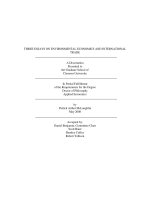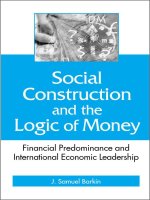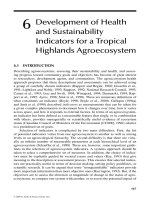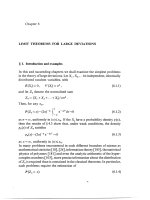Chapter 6 Economies of Scale, Imperfect Competition, and International Trade
Bạn đang xem bản rút gọn của tài liệu. Xem và tải ngay bản đầy đủ của tài liệu tại đây (1.53 MB, 61 trang )
Chapter 6
Economies of
Scale, Imperfect
Competition, and
International Trade
Slides prepared by Thomas Bishop
Preview
• Types of economies of scale
• Types of imperfect competition
Oligopoly and monopoly
Monopolistic competition
• Monopolistic competition and trade
• Inter-industry trade and intra-industry trade
• Dumping
• External economies of scale and trade
Copyright © 2006 Pearson Addison-Wesley. All rights reserved.
6-2
Introduction
• When defining comparative advantage, the Ricardian
model and the Heckscher-Ohlin model both assume
constant returns to scale:
If all factors of production are doubled then output will
also double.
• But a firm or industry may have increasing returns
to scale or economies of scale:
If all factors of production are doubled, then output will more
than double.
Larger is more efficient: the cost per unit of output falls as a
firm or industry increases output.
Copyright © 2006 Pearson Addison-Wesley. All rights reserved.
6-3
Introduction (cont.)
• The Ricardian and Heckscher-Ohlin models also rely
on competition to predict that all income from
production is paid to owners of factors of production:
no “excess” or monopoly profits exist.
• But when economies of scale exist, large firms may
be more efficient than small firms, and the industry
may consist of a monopoly or a few large firms.
Production may be imperfectly competitive in the sense that
excess or monopoly profits are captured by large firms.
Copyright © 2006 Pearson Addison-Wesley. All rights reserved.
6-4
Types of Economies of Scale
• Economies of scale could mean either that
larger firms or that a larger industry (e.g., one
made of more firms) is more efficient.
• External economies of scale occur when
cost per unit of output depends on the size of
the industry.
• Internal economies of scale occur when the
cost per unit of output depends on the size of
a firm.
Copyright © 2006 Pearson Addison-Wesley. All rights reserved.
6-5
Types of Economies of Scale (cont.)
• External economies of scale may result if a
larger industry allows for more efficient
provision of services or equipment to firms in
the industry.
Many small firms that are competitive may
comprise a large industry and benefit from services
or equipment efficiently provided to the large group
of firms.
• Internal economies of scale result when
large firms have a cost advantage over small
firms, which leads to an imperfectly
competitive market.
Copyright © 2006 Pearson Addison-Wesley. All rights reserved.
6-6
A Review of Monopoly
• A monopoly is an industry with only one firm.
• An oligopoly is an industry with only a few firms.
• A characteristic of a monopoly (and to some degree
an oligopoly) is that is marginal revenue generated
from selling an additional unit of output is lower than
the price of output.
Without price discrimination, a monopoly must lower the
price of an additional unit sold, as well as the prices of other
units sold.
The marginal revenue curve lies below the demand curve
(which determines the price of units sold).
Copyright © 2006 Pearson Addison-Wesley. All rights reserved.
6-7
A Review of Monopoly (cont.)
Copyright © 2006 Pearson Addison-Wesley. All rights reserved.
6-8
A Review of Monopoly (cont.)
• Average cost is the cost of production (C)
divided by the total quantity of output
produced (Q) at a time.
AC = C/Q
• Marginal cost is the cost of producing an
additional unit of output.
Copyright © 2006 Pearson Addison-Wesley. All rights reserved.
6-9
A Review of Monopoly (cont.)
• Suppose that costs are measured by C = F + cQ,
where F represents fixed costs, independent of the level
of output.
c represents a constant marginal cost: the constant cost of
producing an additional unit of output Q.
• AC = F/Q + c
• A larger firm is more efficient because average cost
decreases as output Q increases: internal economies
of scale.
Copyright © 2006 Pearson Addison-Wesley. All rights reserved.
6-10
A Review of Monopoly (cont.)
Copyright © 2006 Pearson Addison-Wesley. All rights reserved.
6-11
Monopolistic Competition
•
Monopolistic competition is a model of an
imperfectly competitive industry which
assumes that
1.
Each firm can differentiate its product from the
product of competitors.
2.
Each firm ignores the impact that changes in its
own price will have on the prices competitors set:
even though each firm faces competition it
behaves as if it were a monopolist.
Copyright © 2006 Pearson Addison-Wesley. All rights reserved.
6-12
Monopolistic Competition (cont.)
• A firm in a monopolistically competitive
industry is expected:
to sell more the larger the total sales of the
industry and the higher the prices charged by
its rivals.
to sell less the larger the number of firms in the
industry and the higher its own price.
• These concepts are represented by the
mathematical relationship:
Copyright © 2006 Pearson Addison-Wesley. All rights reserved.
6-13
Monopolistic Competition (cont.)
Q = S[1/n – b(P – P)]
Q is an individual firm’s sales
S is the total sales of the industry
n is the number of firms in the industry
b is a constant term representing the
responsiveness of a firm’s sales to its price
P is the price charged by the firm itself
P is the average price charged by its competitors
Copyright © 2006 Pearson Addison-Wesley. All rights reserved.
6-14
Monopolistic Competition (cont.)
• To make the model easier to understand, we
assume that all firms have identical demand
functions and cost functions.
Thus in equilibrium, all firms charge the same
price: P = P
• In equilibrium,
Q = S/n + 0
AC = C/Q = F/Q + c = F(n/S) + c
Copyright © 2006 Pearson Addison-Wesley. All rights reserved.
6-15
Monopolistic Competition (cont.)
AC = F(n/S) + c
• The larger the number of firms n in the
industry, the higher the average cost for each
firm because the less each firm produces.
• The larger the total sales S of the industry, the
lower the average cost for each firm because
the more that each firm produces.
Copyright © 2006 Pearson Addison-Wesley. All rights reserved.
6-16
Monopolistic
Competition (cont.)
Copyright © 2006 Pearson Addison-Wesley. All rights reserved.
6-17
Monopolistic Competition (cont.)
• If monopolistic firms have linear demand curves,
then the relationship between price and quantity may be
represented as:
Q = A – BxP
where A and B are constants
and marginal revenue may be represented as
MR = P – Q/B
• When firms maximize profits, they set marginal
revenue = marginal cost:
MR = P – Q/B = c
Copyright © 2006 Pearson Addison-Wesley. All rights reserved.
6-18
Monopolistic Competition (cont.)
Q = S[1/n – b(P – P)]
Q = S/n – Sb(P – P)
Q = S/n + SbP – SbP
Q = A – BxP
• Let A S/n + SbP and B ≡ Sb
Copyright © 2006 Pearson Addison-Wesley. All rights reserved.
6-19
Monopolistic Competition (cont.)
MR = P – Q/B = c
MR = P – Q/Sb = c
P = c + Q/Sb
P = c + (S/n)/Sb
P = c + 1/(nxb)
• The larger the number of firms n in the
industry, the lower the price each firm charges
because of increased competition.
Copyright © 2006 Pearson Addison-Wesley. All rights reserved.
6-20
Monopolistic Competition (cont.)
• At some number of firms, the price that
firms charge (which decreases in n) matches
the average cost that firms pay (which
increases in n).
• This number of firms is the number at which
each firm has zero profits: price matches
average cost.
• This number is the equilibrium number
of firms.
Copyright © 2006 Pearson Addison-Wesley. All rights reserved.
6-21
Monopolistic Competition (cont.)
• If the number of firms is greater than or less
than n2, then in industry is not in equilibrium in
the sense that firms have an incentive to exit
or enter the industry.
Firms have an incentive to enter the industry when
profits are greater than zero (price > average cost).
Firms have an incentive to exit the industry when
profits are less than zero (price < average cost).
Copyright © 2006 Pearson Addison-Wesley. All rights reserved.
6-22
Monopolistic Competition and Trade
• Because trade increases market size, trade is
predicted to decrease average cost in an industry
described by monopolistic competition.
Industry sales increase with trade leading to decreased
average costs: AC = F(n/S) + c
• Because trade increases the variety of goods that
consumers can buy under monopolistic competition, it
increases the welfare of consumers.
Because average costs decrease, consumers can also
benefit from a decreased price.
Copyright © 2006 Pearson Addison-Wesley. All rights reserved.
6-23
Monopolistic
Competition
and Trade
(cont.)
Copyright © 2006 Pearson Addison-Wesley. All rights reserved.
6-24
Monopolistic
Competition and Trade (cont.)
• As a result of trade, the number of firms in a
new international industry is predicted to
increase relative to each national market.
But it is unclear if firms will locate in the domestic
country or foreign countries.
Copyright © 2006 Pearson Addison-Wesley. All rights reserved.
6-25









